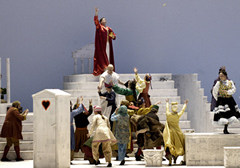by Rosalind Appleby
Hamburg State Opera
2 October 2006
 Peter
Konwitschny's production of La Clemenza di Tito for the Hamburg
State Opera is opera seria turned buffa. Mozart's tribute
opera to ruling nobility becomes a mockery with Tito's throne a wooden
toilet hut and open heart surgery carried out on the Roman Emperor part
way through his Act Two aria. I suspect Mozart's Emperor Leopold II,
for whom the opera was originally written, would have taken grave offence.
But in Germany anything can happen at the opera, and in Hamburg nobody
blinked twice.
Peter
Konwitschny's production of La Clemenza di Tito for the Hamburg
State Opera is opera seria turned buffa. Mozart's tribute
opera to ruling nobility becomes a mockery with Tito's throne a wooden
toilet hut and open heart surgery carried out on the Roman Emperor part
way through his Act Two aria. I suspect Mozart's Emperor Leopold II,
for whom the opera was originally written, would have taken grave offence.
But in Germany anything can happen at the opera, and in Hamburg nobody
blinked twice.
From the opening few bars of the overture director Konwitschny was out to get laughs. Lightening flashes in the dramatic pauses in Mozart's overture provoked an outburst from the conductor Balazs Koscar, who has vocal interjections scripted into the opera throughout.
Eventually the lights were sorted out and the opera began. The cruel Vitellia is introduced, anxious to marry the Emperor and manipulating her besotted lover Sesto at whim. Meanwhile the noble Tito receives gifts from admirers from all corners of the globe, and shares a crate of beer with his buddies. Later while sitting on the toilet he hears his fiancé Servilla confess her secret love for Annio and releases her to marry him; his magnanimity somewhat diminished by the fact his pants are around his ankles. Tito announces his intentions to have Vitellia as his bride, but it is too late for her to stop the plan she has put in motion to kill Servilla and burn down Rome. Her tool Sesto manages to burn down the city but is unsuccessful at killing Servillo. Sesto is discovered and sentenced to death by the shocked Emperor.
Konwitschny finds humour everywhere, despite the vengeful plot: Sesto spends his Act Two aria trying unsuccessfully to kill himself using various gift-wrapped suicide implements; Tito shares his Se all'impero, amici dei aria with a gold Tito statue with flashing eyes who sings a line every now and then; and a collapse by the Emperor results in a Doctor appearing from the audience, who uses a spanner to replace Tito's heart with a fluffy red one. Other strange props appear along the way - apparently references to previous Konwitschny operas - including a megaphone which Publio uses to sound the alarm about the fire, and lions (costumed children) to accompany the Emperor. It's nonsensical and entertaining, but only sometimes enlightening. Why the line of identical Emperor's lining up at a urinal, or the entire cast brawl at the end which knocks over the loo and overshadows the pardon the Emperor has just solemnly given Vitellia and Sesto?
One moment of creativity which is a success is the onstage role for the basset horn soloist. Rupert Wachter gives a darkly sinister interpretation of Mozart's beguiling writing for clarinet and his position onstage emphasises his duet with Vitellia. The minstrel becomes co-conspirator, helping coerce Sesto to carry out Vitellia's murderous plot. By the end of the aria Sesto is dressed in the trench coat and hat of the clarinettist and is ready for action.
Nino Surguladze is the star of this production with a fascinating performance as the love struck boy Sesto. A real male in this role could not be more convincing. Surguladze is a surly, loyal, whimsical and juvenile Sesto, the most believable character in the opera, and sung with a warm clarity. Melanie Diener is a vocally assured, strident Vitellia and Herbert Lippert sings with vigour and clear tone in the title role.
Text: © Rosalind Appleby